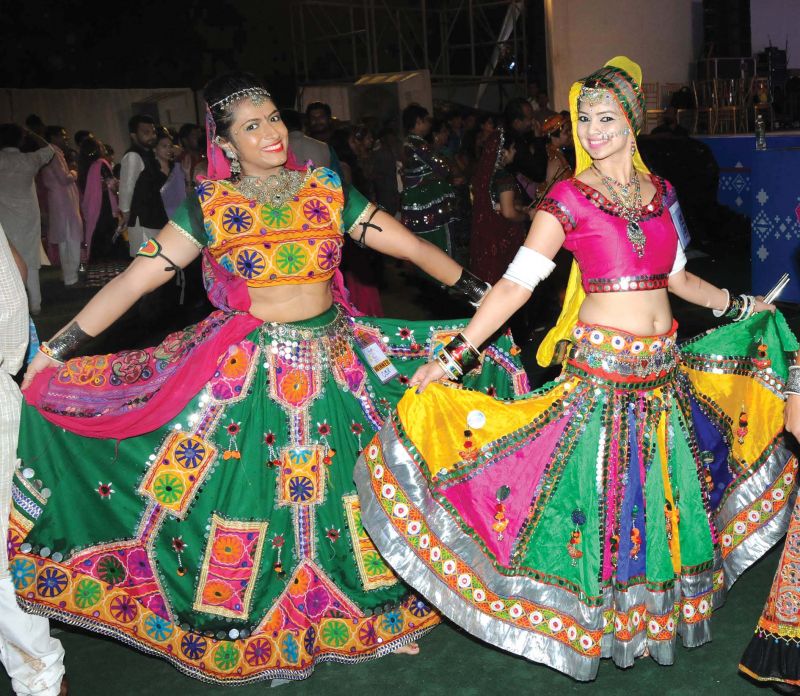D for Dandiya
Over the years, dandiya raas has grown in popularity in South India.

For a first-timer, it begins with the colours. There is blue and green, red and yellow, black and pink, just about everywhere. And the colours move, run, and jump about — dancing. Dandiya for a first-timer is that — full of colours and a lot of joy. The traditional folk dance of Gujarat and Rajasthan, performed as a mock-fight between goddess Durga and Mahishasura, has seeped through borders and come to the south with all its vibrancy. So for Navaratri, young folks down south pick up sticks along with the rest of the country to celebrate the nine days of the festival. And every year, they make it different, while still sticking to the traditions.
The Thiruvananthapuram Gujarati Samaj has been actively putting together dandiya nights for Navaratri over the past many years. Khushi Patel, born and raised in Kerala, speaks Malayalam like a native. She says, “We try to make it different every year. Like doing something called foot dandiya, doing freehand steps only with the feet and avoiding the sticks. We’d wear white shoes and slightly lift the ghagra ends to show it off.” They sometimes choose Bollywood music — songs of Krishna and Radha, and mix them up. Like the Go Go Govinda song from Oh My God or the Gujarati song Char Char Bangdiwala Gaadi. The steps too increased from the original seven steps to 16 and now 32.

“But we stick to the traditional costumes like ghagra choli. It is only once a year we get to wear it,” she says. In Hyderabad, 22-year-old Prem Shankar, son of filmmaker Mani Shankar, is excited about his first dandiya event this year. “I’m a techno producer and DJ. However, I’m organising my first ever dandiya event. We’ve improvised our style and have tried to be innovative by bringing together two of the city’s prolific DJs — DJ Manish and DJ Suman,” he says. Talking about why the events are a hit among youngsters, Prem says, “Garba and Dandiya is very popular among the youngsters because it brings people together and there’s no better way to get together than by dancing!”

He adds, “Traditionally, Garba is performed in devotion to Goddess Durga during the nine holy days of Navaratri ending with the auspicious day of Dusshera. But in today’s day and age, it’s become an integral part of our city’s nightlife and social culture.” Upasana Iyer, a PR professional from Chennai, has been actively participating in dandiya night celebrations in the city. “As per the tradition, dandiya is performed on the 8th and 9th day of Navaratri. Rest of the days it is mostly garba dance, which is more groovy and peppy,” Upasana says.
Garba is performed before the aarti (ritual) and dandiya, after that. Only women perform the garba, while for dandiya, the men folk too join. With its circular movements, dandiya is also slightly more complex. “What has changed over the years is the song selection for the dance. Before, it was only traditional folk songs and bhajans. But these days, it is more of cinematic dance. They select Bollywood numbers for dandiya,” Upasana says.
As far as Chennai is concerned, there isn’t much innovation happening in the dandiya night scene. “Previously, dandiya was performed by those who fast and perform poojas. And it was limited to the Gujarati and Rajasthani communities. But now it has become a fun thing for non-Gujarati people, who come and participate. Everyone is stepping forward, because it is so much fun. Also, this way one can party all night! I have a couple of friends who come for dandiya just to dress up, click pictures and have fun! Girls and boys are crazy about the authentic Gujarati costume — it’s so colourful and nice. Right from a six year old child to a 60-year-old granny, you can find people from all age groups,” she says.
In Bengaluru too, the dandiya fever is catching on. Nikita Ashra, a 28-year-old, who works at HDFC Bank, states, “Every year, dandiya nights happen during Navratri. There’s often a larger turnout of youngsters. Young adults seem a lot more confident about participating. But this time around, the annual competition, which happens at two venues i.e. Gayatri Vihar and Nalapad Pavilion in Palace Grounds, has brought about a refreshing change in terms of making these dance nights open to all ages. Since two winners are adjudged as ‘prince’ and ‘princess’ on the last day of the festivities, I’d like to see how things pan out and how sportive the participants are this time around.”
With inputs from Neha Jha, Merin James, Pooja Chandraprabhan and Cris

